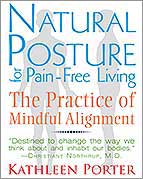
#1 - Establish the Support of a "Happy Dog Pelvis": To do this while sitting on an airplane, sit at your seat with your feet flat on the floor. Lean forward slightly to the left and "walk" your right sit bone farther behind you on the seat. Now repeat to the other side by leaning forward to the right and walking your left sit bone back. Notice that your sit bones are not only further behind you, but they are further apart from each other. Your pubis symphisis or "pubic bone" is now closer to the surface of the seat. Think of yourself as a "happy dog," wagging your tail behind. This is the opposite of a "sad dog" pelvis, where the tail is tucked under and the pubis curls up toward the navel. Tucking your own tail is what causes your spine to round and collapse.
There is still one more part to this. Often, positioning the pelvis like a happy dog (the way all healthy babies naturally sit) will cause your chest to lift up and your lower back to arch. This is almost always due to long-ago conditioning of unnatural patterns in your body. To correct this, maintain a "happy dog pelvis" while exhaling and releasing all tension in your body. Let your chest settle downward. Your head may move forward slightly as well. At first, this may feel quite strange and collapsed but, compared to the over-lifted, chest-up way of sitting, this puts your bones in the correct relationship to each other that releases unnecessary tension in muscles and compression in your spine. As long as you were able to maintain a happy dog pelvis, your bones can provide you with relaxed, upright support, instead of straining muscles having to struggle to hold you up.
#2 - Lean Back While Stretching Out Your Back: With your backrest set upright and your pelvis parked in the happy dog position (see #1 above), place your feet flat on the floor. Begin to slowly lift your lower back up the backrest. Your shoulders will immediately begin to roll forward and rise up toward your ears. Don't worry about this for now. Instead, notice that as you slowly lift your back up, firming sensations can be felt in the deepest "core" postural muscles of support. Notice that this is much deeper and more expansive than simply sucking in your belly (something you want to avoid doing). Once your back is as high up the backrest as possible, anchor it there, as if glued, onto the backrest. Let your shoulders roll back onto the backrest and your head come up, while maintaining maximum length in the back of the neck. Now RELAX! You will probably need to repeat this multiple times during the flight, but it will help to lengthen out your spine and widen your back, releasing compression and bringing relief to chronically shortened, tight muscles.
#3 - Don't Just Fly—WALK Your Way to Your Destination (without ever leaving your seat!): Even at 35,000 feet you can engage your connection to the Earth and reap many benefits doing so. With your feet placed flat, with your knees directly over your ankles, begin to push one of your feet into the floor. Do this slowly at first, beginning to push harder, and taking the time to feel the growing response up through your leg, into your hip and pelvis and wherever else in your body you experience a flow of energy and movement rising through you. Repeat this with your other foot, taking notice of how the push of your foot extends the sit bone on the same side further behind you. Can you feel how your legs, hips and back are all enlivened by this "grounding" into the "earth"? You can speed up your "walk" now, and as you do so, you will stimulate the flow of blood and oxygen throughout your body. You can even share this exercise with whoever is lucky enough to be sitting next to you. They'll be thanking you when the plane lands, as they, like you, will arrive at the destination feeling both relaxed and revitalized!
About the Author:
Kathleen Porter is the director of the Center for Natural Alignment in Portland, Oregon. She offers programs for people with posture-related pain and for children and teachers in classrooms. She has taught principles of natural alignment at the University of Hawaii at Hilo, the National College of Natural Medicine in Portland, Oregon, and the Omega Institute in Rhinebeck, New York. She lives in Portland, Oregon.
There is still one more part to this. Often, positioning the pelvis like a happy dog (the way all healthy babies naturally sit) will cause your chest to lift up and your lower back to arch. This is almost always due to long-ago conditioning of unnatural patterns in your body. To correct this, maintain a "happy dog pelvis" while exhaling and releasing all tension in your body. Let your chest settle downward. Your head may move forward slightly as well. At first, this may feel quite strange and collapsed but, compared to the over-lifted, chest-up way of sitting, this puts your bones in the correct relationship to each other that releases unnecessary tension in muscles and compression in your spine. As long as you were able to maintain a happy dog pelvis, your bones can provide you with relaxed, upright support, instead of straining muscles having to struggle to hold you up.
#2 - Lean Back While Stretching Out Your Back: With your backrest set upright and your pelvis parked in the happy dog position (see #1 above), place your feet flat on the floor. Begin to slowly lift your lower back up the backrest. Your shoulders will immediately begin to roll forward and rise up toward your ears. Don't worry about this for now. Instead, notice that as you slowly lift your back up, firming sensations can be felt in the deepest "core" postural muscles of support. Notice that this is much deeper and more expansive than simply sucking in your belly (something you want to avoid doing). Once your back is as high up the backrest as possible, anchor it there, as if glued, onto the backrest. Let your shoulders roll back onto the backrest and your head come up, while maintaining maximum length in the back of the neck. Now RELAX! You will probably need to repeat this multiple times during the flight, but it will help to lengthen out your spine and widen your back, releasing compression and bringing relief to chronically shortened, tight muscles.
#3 - Don't Just Fly—WALK Your Way to Your Destination (without ever leaving your seat!): Even at 35,000 feet you can engage your connection to the Earth and reap many benefits doing so. With your feet placed flat, with your knees directly over your ankles, begin to push one of your feet into the floor. Do this slowly at first, beginning to push harder, and taking the time to feel the growing response up through your leg, into your hip and pelvis and wherever else in your body you experience a flow of energy and movement rising through you. Repeat this with your other foot, taking notice of how the push of your foot extends the sit bone on the same side further behind you. Can you feel how your legs, hips and back are all enlivened by this "grounding" into the "earth"? You can speed up your "walk" now, and as you do so, you will stimulate the flow of blood and oxygen throughout your body. You can even share this exercise with whoever is lucky enough to be sitting next to you. They'll be thanking you when the plane lands, as they, like you, will arrive at the destination feeling both relaxed and revitalized!
About the Author:
Kathleen Porter is the director of the Center for Natural Alignment in Portland, Oregon. She offers programs for people with posture-related pain and for children and teachers in classrooms. She has taught principles of natural alignment at the University of Hawaii at Hilo, the National College of Natural Medicine in Portland, Oregon, and the Omega Institute in Rhinebeck, New York. She lives in Portland, Oregon.

 RSS Feed
RSS Feed